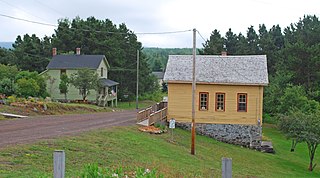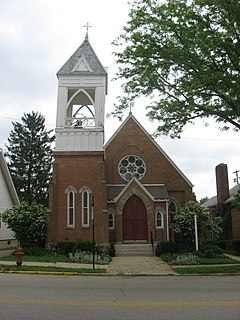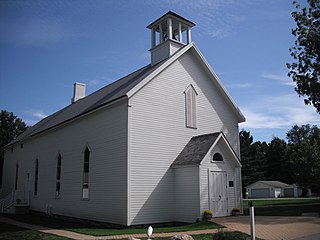
Calumet is a village in Calumet Township, Houghton County, in the U.S. state of Michigan's Upper Peninsula, that was once at the center of the mining industry of the Upper Peninsula. Also known as Red Jacket, the village includes the Calumet Downtown Historic District, listed on the National Register of Historic Places (NRHP). The village may itself be included within the Calumet Historic District, a larger area which is NRHP-listed and which is a National Historic Landmark District. It is bordered on the north by Calumet Township, on the south by the unincorporated towns of Newtown and Blue Jacket, on the east by Blue Jacket and Calumet Township, and on the west by Yellow Jacket and Calumet Township. The population was 726 at the 2010 census. Calumet's nickname is Copper Town U.S.A.

The Quincy Mine is an extensive set of copper mines located near Hancock, Michigan. The mine was owned by the Quincy Mining Company and operated between 1846 and 1945, although some activities continued through the 1970s. The Quincy Mine was known as "Old Reliable," as the Quincy Mine Company paid a dividend to investors every year from 1868 through 1920. The Quincy Mining Company Historic District is a United States National Historic Landmark District; other Quincy Mine properties nearby, including the Quincy Mining Company Stamp Mills, the Quincy Dredge Number Two, and the Quincy Smelter are also historically significant.

Keweenaw National Historical Park is a unit of the U.S. National Park Service. Established in 1992, the park celebrates the life and history of the Keweenaw Peninsula in the Upper Peninsula of the U.S. state of Michigan. As of 2009, it is a partly privatized park made up of two primary units, the Calumet Unit and the Quincy Unit, and 21 cooperating "Heritage Sites" located on federal, state, and privately owned land in and around the Keweenaw Peninsula. The National Park Service owns approximately 1,700 acres (690 ha) in the Calumet and Quincy Units. Units are located in Baraga, Houghton, Keweenaw, and Ontonagon counties.

The following is a list of Registered Historic Places in Keweenaw County, Michigan.

The Soul Harvest Ministries is located at 16300 Woodward Avenue in Highland Park, Michigan. It was built in 1916 as the First United Methodist Church and listed on the National Register of Historic Places in 1982.

Bardsdale United Methodist Church is a historic church located at 1498 Bardsdale Avenue in the unincorporated community of Bardsdale, California, in Ventura County. It is south of the Santa Clara River approximately 3 miles (5 km) from Fillmore.

The First Methodist Church in Monroe, Green County, Wisconsin, now the Monroe Arts Center, is a Gothic Revival edifice designed by the former Wisconsin State Architect E. Townsend Mix of Milwaukee and constructed of Cream City brick. It was commissioned in 1869 by the First Methodist Episcopal congregation of Monroe to replace an earlier church building that dated to 1843. The adjacent parsonage was completed in 1886, and the complete ensemble was finally dedicated in 1887.

The Calumet Historic District is a National Historic Landmark District that encompasses most of the village of Calumet, Michigan. The district was designated in 1989 for the community's importance in the history of the region's copper mining industry.

The Church of the Assumption is an historic Carpenter Gothic style Roman Catholic church located on US 41, 400 feet east of M-26 in Phoenix in Houghton Township, Michigan. It is also known as the Phoenix Church. The church was listed on the National Register of Historic Places in 2000.

The Central Mine Historic District is a historic district located off US 41 in Upper Michigan. The mine itself was designated a Michigan State Historic Site in 1958, while the surrounding district was designated a Michigan State Historic Site in 1973 and listed on the National Register of Historic Places in 1974.

The Hancock Town Hall and Fire Hall is a public building located at 399 Quincy Street in the Quincy Street Historic District in Hancock, Michigan. It is also known as the Hancock City Hall. It was designated a Michigan State Historic Site in 1977 and was listed on the National Register of Historic Places in 1981.

Built in 1912, the First Presbyterian Church of Redmond is the oldest standing church structure in the city of Redmond, Oregon, United States. It is also the second-oldest religious building in Deschutes County. The church was built in the Gothic Revival style with Queen Anne architectural detailing. It was the home of Protestant congregations from 1912 until 1979. Today, the building is privately owned and used as a special events venue. The First Presbyterian Church of Redmond was listed on the National Register of Historic Places in 2001.

Old Christ Church is a historic Episcopal church at the junction of Vermont Route 12 and Gilead Brook Road in Bethel, Vermont. Built in 1823, it is a well-preserved Federal period church, lacking modern amenities such as electricity and plumbing. The church was added to the National Register of Historic Places in 2008. It is used for services only during the summer.

The Church of Our Saviour is a historic Episcopal parish in the village of Mechanicsburg, Ohio, United States. Founded in the 1890s, it is one of the youngest congregations in the village, but its Gothic Revival-style church building that was constructed soon after the parish's creation has been named a historic site.

St. Barnabas Episcopal Church is a former church building in the Episcopal Diocese of Iowa located in Montrose, Iowa, United States. It was listed on the National Register of Historic Places in 1986. The building is now called St. Barnabas Wedding Chapel.

The First Methodist Episcopal Church of Pokagon is a historic church at 61041 Vermont Street in Pokagon Township, Michigan. It is the location of the first performance of the hymn "The Old Rugged Cross." The church was listed as a Michigan State Historic Site in 2000 and added to the National Register of Historic Places in 2002.

The First Methodist Episcopal Church, also known as the Red Church, is a historic church located at 4451 Second Street in Port Hope, Michigan. It was listed on the National Register of Historic Places in 1987.

The Central Methodist Episcopal Church is a historic church located at 215 North Capitol Avenue in Lansing, Michigan. It was listed on the National Register of Historic Places in 1980.

Muir Church of Christ, also known as the First Christian Church of Muir, is a historic church located at 138 Garden Street in Muir, Michigan. It was built in 1861 and added to the National Register of Historic Places in 1983.

The Elk Rapids First Methodist Episcopal Church is a former church located at 301 Traverse Street in Elk Rapids, Michigan. The building now houses Elk Rapids Area Historical Museum. It was listed on the National Register of Historic Places in 2015.























